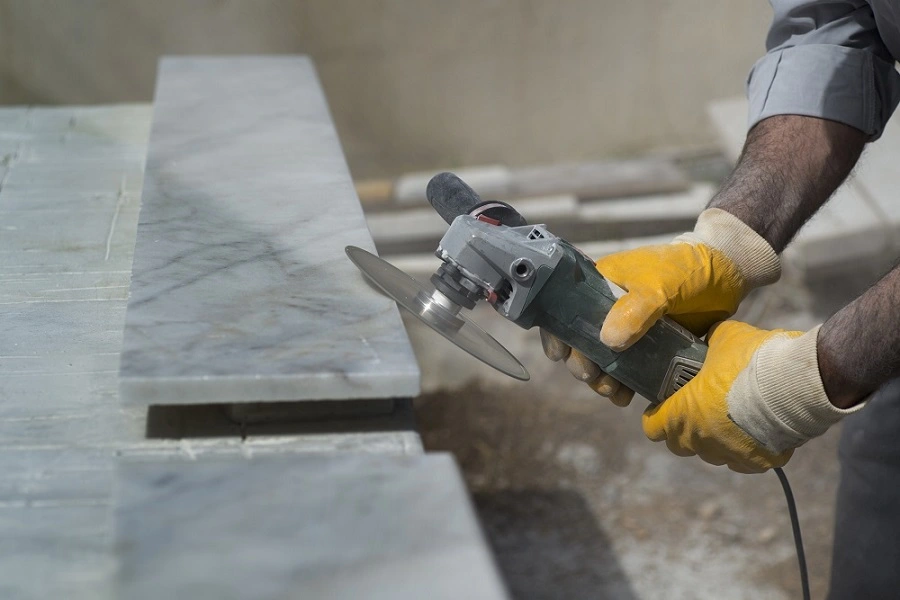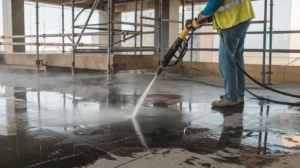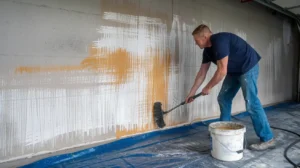Cultured marble repair involves restoring and fixing surfaces made of cultured marble. Cultured marble is a blend of crushed natural stone and polyester resins, often used in countertops, vanities, and other household surfaces.
It mimics the appearance of natural marble but is more durable and easier to maintain. Despite its resilience, cultured marble can still suffer from chips, cracks, stains, or other forms of damage over time. Therefore, maintaining these surfaces is crucial to preserve their aesthetic appeal and functionality.
Can Cultured Marble Be Polished?
Yes, cultured marble can be polished to restore its shine and appearance. Here’s an exploration of polishing techniques for cultured marble, factors to consider before polishing, and the pros and cons of polishing cultured marble:
Polishing Techniques for Cultured Marble:
Surface Preparation:
- Clean the surface thoroughly to remove any dirt, grime, or stains.
- Sand the surface lightly with fine-grit sandpaper to remove any surface imperfections or scratches.
Polishing Compounds:
- Use a specialized marble polishing compound or polish specifically designed for cultured marble.
- Apply the polish evenly over the surface using a soft cloth or a polishing pad attached to a buffer.
Polishing Process:
- Buff the surface in circular motions, applying gentle pressure.
- Continue buffing until the desired level of shine is achieved.
- Wipe off any excess polish with a clean, damp cloth.
Final Touches:
- Optionally, apply a sealant or wax to protect the polished surface and enhance its longevity.
Factors to Consider Before Polishing Cultured Marble:
Condition of the Surface:
- Assess the condition of the cultured marble to determine if it’s suitable for polishing.
- Deep scratches or cracks may require professional repair before polishing.
Type of Finish:
- Consider the type of finish on the cultured marble (e.g., glossy or matte) and choose the appropriate polishing products accordingly.
Tools and Equipment:
- Ensure you have the necessary tools and equipment for the polishing process, such as polishing compounds, buffing pads, and a buffer machine.
Pros and Cons of Polishing Cultured Marble:
Pros:
Restores Appearance: Polishing can revive the shine and luster of cultured marble, making it look like new again.
Cost-Effective: Polishing is generally more affordable than replacing the entire surface of cultured marble.
DIY Option: With the right tools and techniques, polishing cultured marble can be done as a DIY project, saving on labor costs.
Cons:
Risk of Damage: Over-polishing or using abrasive materials can damage the surface of cultured marble.
Time-Consuming: Polishing may require multiple steps and sufficient drying time between applications, making it a time-consuming process.
Temporary Solution: While polishing can improve the appearance of cultured marble, it may not address underlying structural issues or permanent stains.
Repairing Scratches in Cultured Marble
Understanding Common Causes of Scratches on Cultured Marble
Cultured marble is a popular material for countertops, sinks, and other surfaces due to its durability and aesthetic appeal. However, it is susceptible to scratches if not handled properly. Common causes of scratches on cultured marble include:
Abrasive Cleaning Products: Harsh chemicals and abrasive cleaners can scratch the surface of cultured marble. Always use mild, non-abrasive cleaners specifically formulated for use on marble surfaces.
Improper Cleaning Tools: Rough sponges, scrub brushes, or scouring pads can leave scratches on the surface of cultured marble. Opt for soft cloths or sponges when cleaning to avoid damage.
Impact Damage: Dropping heavy objects or sharp items onto cultured marble surfaces can cause scratches or chips. Be cautious when handling heavy items around cultured marble surfaces to prevent damage.
Normal Wear and Tear: Over time, everyday use can lead to minor scratches on cultured marble surfaces. While unavoidable, regular maintenance can help minimize the appearance of scratches and keep the surface looking its best.
Assessment of Scratch Severity
Before attempting to repair scratches on cultured marble, it’s essential to assess the severity of the damage. Minor scratches may only require simple repairs, while deeper scratches may necessitate more advanced techniques. Here’s how to assess scratch severity:
Minor Scratches: Minor scratches are shallow and barely noticeable. They may appear as faint lines or surface imperfections. These scratches typically do not penetrate the entire depth of the cultured marble and can be easily repaired with basic techniques.
Deep Scratches: Deep scratches are more pronounced and may extend below the surface of the cultured marble. They are often visible to the naked eye and can detract from the appearance of the surface. Repairing deep scratches may require more extensive measures to restore the surface to its original condition.
Step-by-Step Guide to Repairing Minor Scratches
If you have minor scratches on your cultured marble surface, you can follow these steps to repair them:
Clean the Surface: Begin by thoroughly cleaning the scratched area with a mild, non-abrasive cleaner and warm water. This will remove any dirt, grime, or residue from the surface, allowing for better adhesion of the repair materials.
Sand the Scratch: Use a fine-grit sandpaper (around 400-600 grit) to gently sand the scratched area. Sand in a circular motion, applying light pressure, until the scratch becomes less noticeable. Be careful not to sand too aggressively, as this can cause further damage to the surface.
Polish the Surface: Once the scratch has been sanded down, use a marble polishing compound to buff the area and restore the shine to the surface. Apply the polishing compound according to the manufacturer’s instructions, using a soft cloth or buffer to achieve a smooth, glossy finish.
Seal the Surface: To protect the repaired area and prevent future damage, apply a marble sealant or wax to the surface. Follow the manufacturer’s recommendations for application and drying times to ensure optimal results.
Buff the Surface: After the sealant has dried, use a clean, dry cloth to buff the surface to a high shine. This will help blend the repaired area with the surrounding surface and achieve a uniform finish. If you want professional guidance then Stone Sealer Restoration is best in business
Should We Consider Cultured Marble Repair?

Evaluating the Condition of Cultured Marble Surfaces:
Before making a decision on whether to repair or replace cultured marble surfaces, it’s crucial to assess their current condition. Look for signs of damage such as cracks, chips, scratches, stains, or discoloration. Evaluate the extent of the damage and consider whether it affects the functionality or aesthetics of the surface.
Benefits of Repairing vs Replacing Cultured Marble:
Repairing cultured marble can offer several benefits compared to replacement. It is often more cost-effective and less disruptive, especially if the damage is minor. Repairing also preserves the original appearance and texture of the surface, avoiding the need for complete replacement.
Cost Comparison Repairing vs Replacement:
Cost is a significant factor in deciding whether to repair or replace cultured marble surfaces. Repairing damaged areas typically costs less than replacing the entire surface. Consider factors such as labor, materials, and any additional expenses associated with replacement, such as demolition and disposal fees.
Environmental Impact of Cultured Marble Repair:
Repairing cultured marble surfaces can have a lower environmental impact compared to replacement. Repairing preserves existing materials, reducing the need for new resources and minimizing waste sent to landfills. Additionally, repair processes often use eco-friendly techniques and materials, further reducing environmental harm.
Advantages of Cultured Marble Repair

Restoring Aesthetic Appeal: Repairing cultured marble surfaces can restore their original appearance, eliminating blemishes, cracks, or discoloration, thus enhancing the overall aesthetic appeal of the space.
Extending the Lifespan of Cultured Marble Surfaces: By promptly addressing any damages through repair, the lifespan of cultured marble surfaces can be significantly extended, preventing minor issues from escalating into larger, more costly problems.
Cost-Effectiveness Compared to Replacement: Repairing cultured marble is generally more cost-effective than replacing entire surfaces. It saves on material costs, labor, and reduces the disruption caused by extensive renovations.
Flexibility in Addressing Various Types of Damage: Cultured marble repair techniques offer flexibility in addressing a wide range of damages, including scratches, chips, cracks, and stains, ensuring comprehensive restoration of the surface.
Eco-Friendly Approach to Maintenance: Repairing cultured marble surfaces instead of replacing them aligns with eco-friendly principles by reducing waste generation and minimizing the need for new material extraction and manufacturing processes. It promotes sustainability in maintenance practices.
Conclusion
Addressing cultured marble repair involves several key points to consider. Firstly, understanding the nature of the damage is crucial in determining the appropriate repair method. Whether it’s a chip, crack, or discoloration, each issue may require a different approach.
Secondly, selecting the right repair materials and tools is essential for achieving satisfactory results. Utilising high-quality repair kits and following proper techniques can significantly enhance the outcome of the repair process. Feel free to contact us for any type of query or services related to carrara marble.
FAQs
What Is Cultured Marble Repair?
Cultured marble repair involves fixing any damages or imperfections that may occur on surfaces made of cultured marble, such as chips, cracks, or scratches.
Can I Repair Cultured Marble Myself?
Yes, minor repairs to cultured marble can often be done by homeowners using DIY repair kits available in the market. However, for more extensive damage, it’s advisable to seek professional assistance.
What Types Of Damage Can Be Repaired On Cultured Marble?
Cultured marble repair kits are typically designed to address various types of damage, including chips, cracks, scratches, and surface stains.
How Do I Repair A Chip Or Crack In Cultured Marble?
Repairing a chip or crack in cultured marble usually involves filling the damaged area with a specially formulated repair compound, followed by sanding and polishing to blend it seamlessly with the surrounding surface.
Can Cultured Marble Be Repaired If It’s Discolored?
Yes, discoloration on cultured marble surfaces can often be remedied using specific cleaning agents or polishing compounds designed to restore the original color and shine.
Is It Possible To Repair A Large Crack In Cultured Marble?
While small cracks can typically be repaired using DIY kits, larger cracks may require professional intervention, as they may indicate structural issues that need to be addressed.





